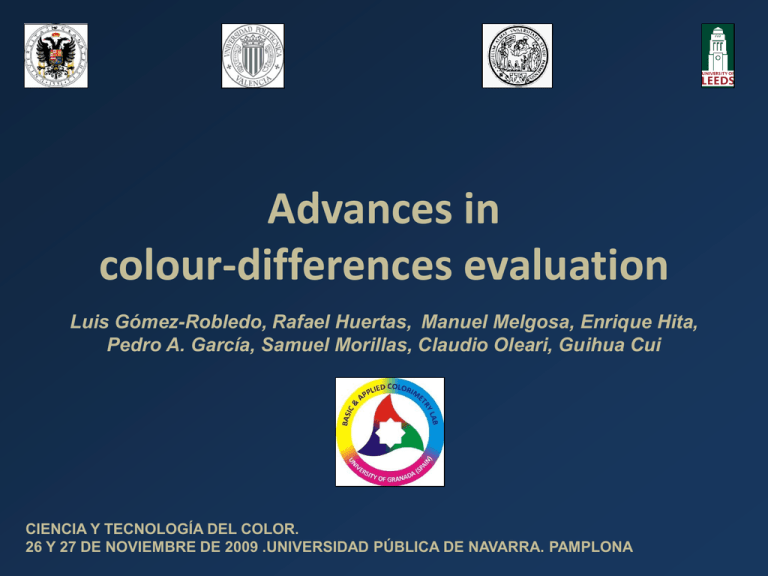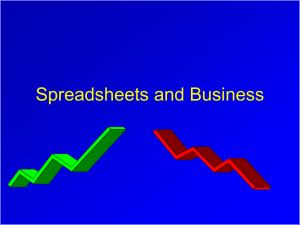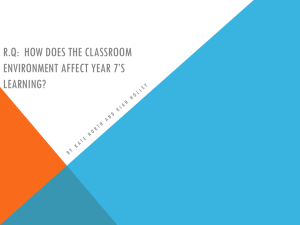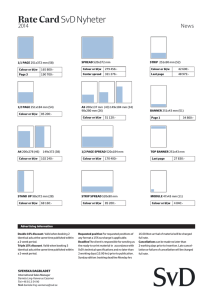Testing colour-differences formulas
advertisement

Advances in colour-differences evaluation Luis Gómez-Robledo, Rafael Huertas, Manuel Melgosa, Enrique Hita, Pedro A. García, Samuel Morillas, Claudio Oleari, Guihua Cui CIENCIA Y TECNOLOGÍA DEL COLOR. 26 Y 27 DE NOVIEMBRE DE 2009 .UNIVERSIDAD PÚBLICA DE NAVARRA. PAMPLONA 2 /26 INDEX 1. Introduction 2. Testing colour-differences formulas. STRESS 3. Colour-differences in OSA-UCS space 4. Testing colour-differences databases. Fuzzy method. 5. Checking Recent Colour-Difference Formulas with a Dataset of Just Noticeable Colour-Difference. 3 /26 Introduction Introduction 4/26 R G B XYZ CMC OSA-GPe OSA-GP CIE94 CIELAB CAM02 CIEDE2000 DIN99 ¿Wich metric must we use? Introduction 5/26 Division 1: Vision and Colour TC1-27 TC1-36 TC1-37 TC1-41 TC1-42 TC1-44 TC1-54 TC1-55 TC1-56 TC1-57 TC1-58 TC1-60 TC1-61 TC1-63 TC1-64 TC1-66 TC1-67 TC1-72 TC1-68 TC1-69 TC1-70 TC1-71 TC1-73 TC1-74 Colour appearance for reflection/VDU comparison Fundamental chromaticity diagram Supplementary system of photometry Extension of V(l) beyond 830nm Colour appearance in peripheral vision Practical daylight sources for colorimetry Age-related change of visual response Uniform colour space for industrial colour difference evaluation Improved color matching functions Standards in colorimetry Visual performance in the mesopic range Contrast sensitivity function Categorical colour identification Validity of the range of CIEDE2000 Terminology for vision, colour, and appearance Indoor daylight illuminant The effect of ation Measurement odynamic and stereo visual images on human health Effect of stimulus size on colour appearance Colour rendition by white light sources Metameric sample for indoor daylight evaluation Tristimulus integrf appearance network: MApNet Real colour gamuts Methods for Re-Defining CIE D-Illuminants 7/26 Testing colour-differences Formulas. STRESS index Introduction 8/26 E*ab E00 5.5 7.9 5.4 2.6 5.6 5.1 3.9 2.0 4.1 2.4 From Test Targets 8.0, Prof. Bob Chung. Rochester Institute of Technology, NY, USA Testing colour-differences formulas 9/26 PERFORMANCE FACTOR PF/3 (Luo et al. ,1999). Perfect Agreement: 2 E E 1 i i l o g l o g l o g 1 0 1 0 1 0 N V V i 1 i i N E F V 1 i i V A B N E V i 1 iF i N 2 N F i Vi V Ei i1 N i VAB = 0 N 2 E i1 Ef V 1N i i C V 1 0 0 2 N i 1 E log10) 1 f E V i 1 N i i V i 1 CV = 0 2 i 1 0 0 1 V C V A B P F / 3 3 PF/3 = 0 Testing colour-differences formulas 10/26 Proposal of STRESS index (Kruskal’s STRESS) (STandardized REsidual Sum of Squares) Vi F Ei 2 STRESS 100 2 Vi 2 V S T R E S S A F A 2 V S T R E S S B B Assuming the same set of ∆Vi (i=1…N) data E V E F i 0 ≤ STRESS ≤ 100 i 2 i Perfect Agreement STRESS = 0 F < FC A is significantly better than B F > 1/FC A is significantly poorer than B FC ≤ F <1 A is insignificantly better than B 1 < F ≤ 1/ FC A is insignificantly poorer than B F=1 A is equal to B P.A. García, R. Huertas, M. Melgosa, G. Cui. JOSA A, 24 (7), 1823-1829, 2007 Testing colour-differences formulas 11/26 STRESS (%)for the three last CIE recommended formulas COM Weighted (11273 color pairs) For COM Weighted each one of corrections proposed by CIEDE2000 or CIE94 were found statistically significant at 95% confidence level. CIEDE2000 (but not CIE94) significantly improves CMC. Testing colour-differences formulas 12/26 STRESS (%) increase for reduced models & COM Weighted 14/26 Colour-differences in OSA-UCS space Colour-differences in OSA-UCS space 15/26 The GP (Granada-Parma) formulas R. Huertas et al. JOSA A 23, 2077-2084 (2006) C. Oleari et al. JOSA A 26, 121-134 (2009) See references for definitions of (LOSA, COSA, HOSA ). The format is analogous to the CIE94 one. 1 0 L 1 0 C 1 0 H O S A O S A O S A E G P S S S L C H 2 2 2 S 1.2350.0581 0C S 1.3920.0171 0C SL 2.4990.00710L O SA C O SA C O SA Similar STRESS% than CIEDE2000, but simpler and physiologically based Colour-differences in OSA-UCS space 16/26 E L G J G P , E 2 O S A , E 2 E 2 E 1 0.015 LE 10LOSA ln 1 0.015 2.890 1 0.050 CE 10COSA ln 1 0.050 1.256 J h arctan G GE CE cos(h) JE CE sin(h) • Note that GE axis is green-red, just opposite to CIELAB a* axis. • Compression is used in the chroma equation (very important), and also in lightness (less important). Similar STRESS% than CIEDE2000, but simpler and physiologically based Colour-differences in OSA-UCS space CIELAB 17/26 DIN99d CAM02-SCD GP, Euc Testing colour-differences formulas 18/26 STRESS (%) 30 20 10 0 CIEDE2000 DIN99d DE(GP,Euc) CAM02-SCD Fórmulas de Diferencia de Color STRESS results are very close to those of CIEDE2000, and new formulas are both simpler (Euclidean) and increasingly based on physiology. Anyway a ~25% STRESS is an “unsatisfactory state of affairs” (R. Kuehni, CR&A, 2008), and new reliable experimental data are required. Testing colour-differences formulas 19/26 60 COM Unweighted Data (3813 color pairs) STRESS (%) 50 TC 1- 63 CIELAB OSAGP CAMUCS CAMSCD DIN99 CIE00 CIE94 40 30 >9 ,0 0, 51, 0 1, 01, 5 1, 52, 0 2, 02, 5 2, 53, 0 3, 03, 5 3, 54, 0 4, 04, 5 4, 55, 0 5, 06, 0 6, 07, 0 7, 09, 0 00, 5 20 CIELAB Range • The performance of all formulas strongly deteriorates below 1.0 CIELAB unit. • CIELAB and CIE94 are worse than the other formulas in most ranges. • At highest ranges all formulas are slightly worse (except CIELAB and CIE94). 21/26 Testing colour-differences databases. Fuzzy Metric method. Testing colour-differences databases. Fuzzy Metric method 22/26 Fuzzy analysis for detection of inconsistent data in the experimental datasets employed at the development of the CIEDE2000 colour-difference formula (JMO,56:13,1447-1456, 2008) Vi Ri Ei F M (, R R , ) RR i i i i i E V N (S)R S SS , jSi j R i Si 1 j Sj SS , jSi j i ( ) (R R ) NS j N (S) Si 1 i S S ,S S i j j S i 1 j i ( ) NS S S ,S S j j i (unreliable) 0 FM 1 ( perfect reliability) FM give us an idea if pair i agrees with its near neighbors 2 j S i 1 j i Testing colour-differences databases. Fuzzy Metric method Data with lowest mean FM in corrected COM correspond with cases of low colour difference for which its V is overestimated. On the other hand, data with highest FM seem to match with cases of best linear correlation. 23/26 26/26 Thank you for your attention









